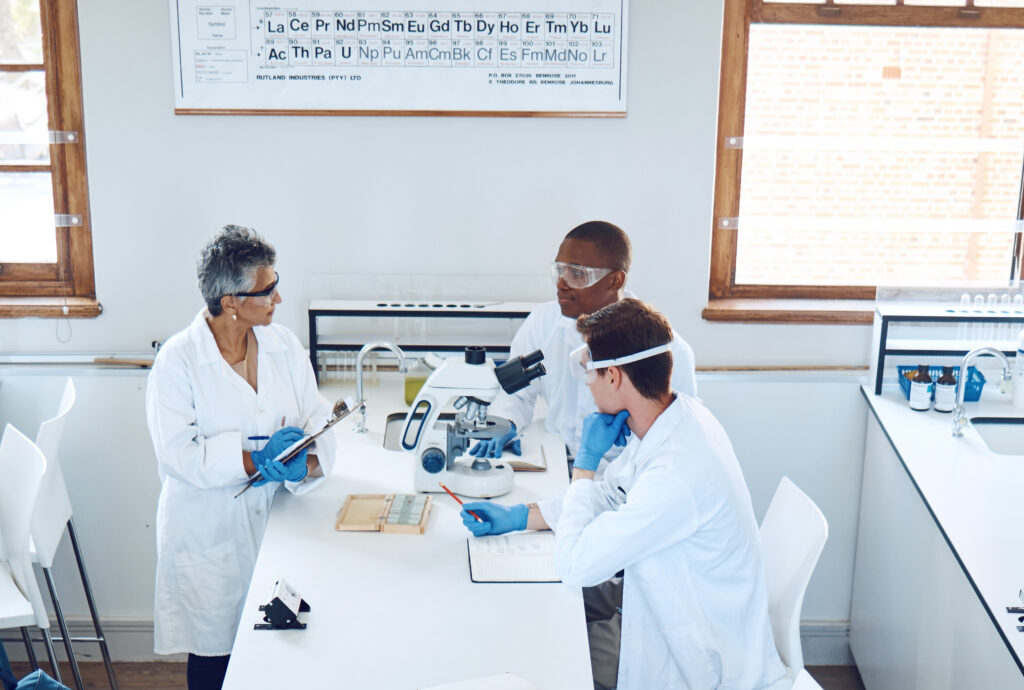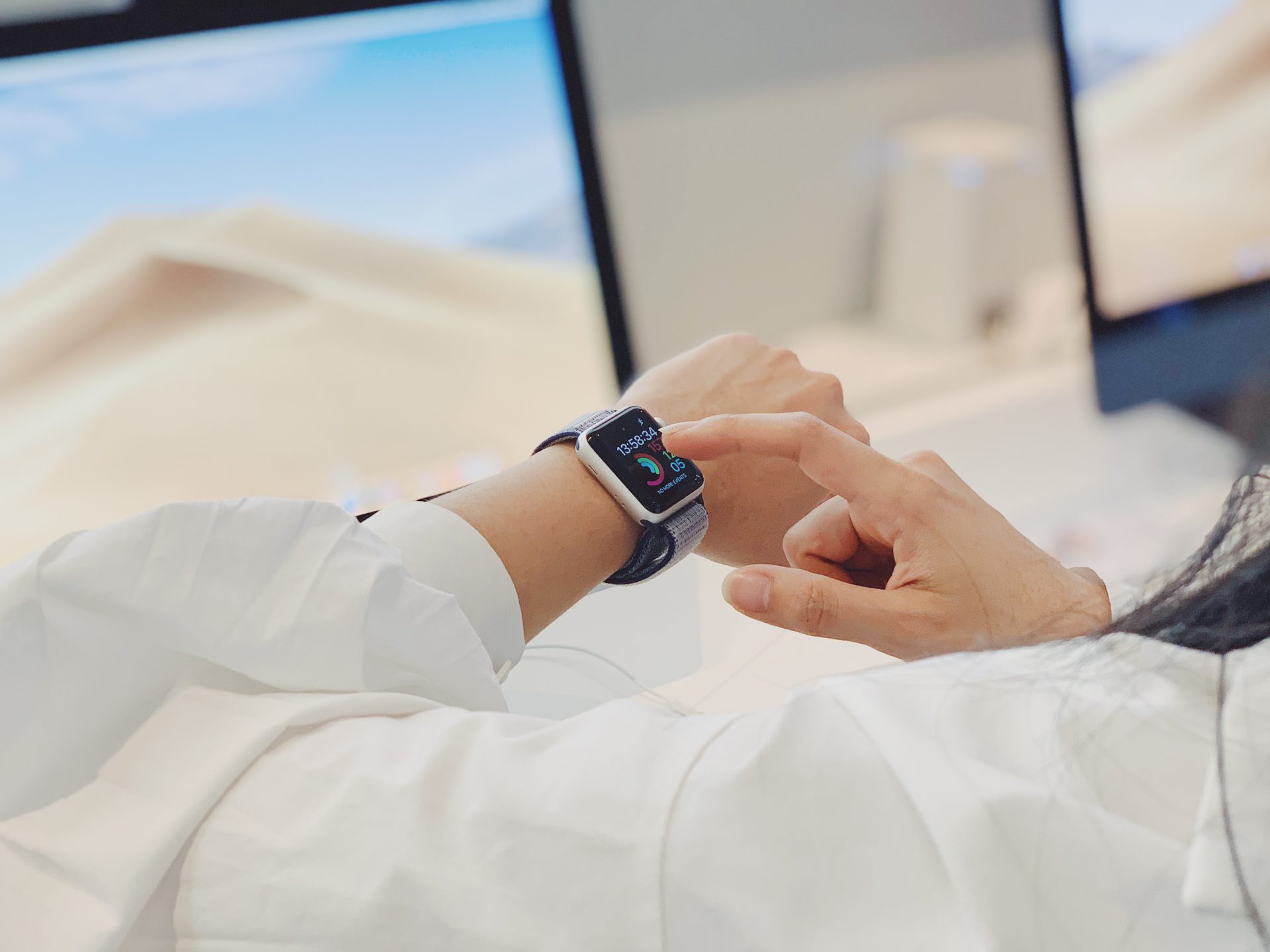
Introduction
Wearables are increasingly becoming the essential health and wellness gadget. Once limited to step counts and fitness logs, they now shape daily health engagement. Advances in biometric sensing and AI deliver tailored insights, enabling users to track sleep, stress, recovery, and overall wellbeing with growing precision and ease.
The industry’s global growth highlights wearables’ new role in health. Shipments exceeded 530 million units in 2024, a 5.4% rise from the previous year. This expansion stems less from hardware gains and more from new use cases built on real-time health awareness. As devices shift from passive trackers to intelligent companions, they are redefining preventive care and personal wellness.
Market Leaders in Everyday Health Intelligence
The key players in the wearables market compete on insights, not sensors. Most devices now share a core baseline—heart rate, sleep, blood oxygen, and skin temperature. What sets them apart is how data is translated into personalized guidance. Each brand defines wellness through its models, behaviors, and user journeys, shaping distinct paths in everyday health.
Brands reflect diverse but converging paths in wearable health. Some emphasize ecosystem integration and accessibility, like Apple’s seamless connection across devices, while others differentiate through data depth and personalization, as seen in Garmin’s performance analytics and Whoop’s AI-based recovery feedback. Yet all share a focus on continuous monitoring, wellness optimization, and user empowerment.
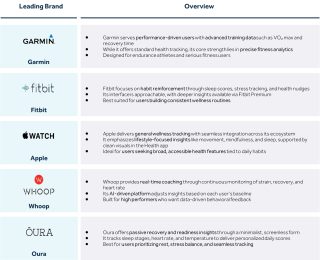
Key Drivers Behind Wearable Adoption
Wearables are no longer viewed as tools for fitness enthusiasts alone. A 2024 survey published in NPJ Digital Medicine found that fitness and workout tracking remain the leading reason for adoption, with nearly 65% of respondents identifying it as their primary motivation. At the same time, the findings reveal a growing demand for broader health applications, extending beyond steps and calorie counts toward more comprehensive measures of wellbeing.
Health tracking is emerging as a central driver of adoption. Around 60% of survey participants cited it as either a primary or secondary reason for using wearables. Sleep monitoring followed closely, with more than half of respondents naming it as a key factor. Together, these findings highlight shifting expectations, as consumers increasingly view wearables as tools for continuous, proactive health management rather than occasional fitness support.
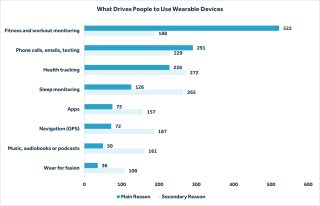
Source: NPJ Digital Medicine (2024)
As wearables grow into everyday health companions, user habits are evolving alongside. Devices once centered on steps and pace are now valued for supporting sleep quality, recovery, and stress awareness. This shift reflects a deeper integration of technology into daily wellbeing routines, positioning wearables as active enablers of healthier lifestyles.
How Wearables Are Shaping Preventative Health
Wearables have evolved with increasingly innovative health monitoring technologies. They now alert users to subtle physiological changes (e.g., elevated resting heart rate, reduced heart rate variability, or irregular sleep patterns) that may indicate shifts well before traditional methods can detect them. The value lies less in formal diagnosis and more in raising awareness, prompting timely lifestyle adjustments or encouraging earlier medical consultation. Wearables are moving beyond passive monitoring into early detection and recovery support. Recent studies indicate that conditions such as atrial fibrillation can be identified with increasing accuracy through consumer devices like smartwatches, Oura rings, or CART-I rings, particularly when insights are paired with electronic health records and user-reported data.
These insights capture a simple yet powerful health journey, one that begins with baseline tracking and leads to greater awareness and action. While not diagnostic, such signals serve as early cues, encouraging users to rest, pursue testing, or seek medical consultation when needed. Modern wearables have shifted from passive recorders to personalized wellness coaches. Powered by artificial intelligence and machine learning, they translate raw physiological signals into tailored insights, guiding behaviors and supporting healthier choices at the individual level. AI-powered sensors now enable continuous tracking across a wide range of body metrics. From heart rate and sleep patterns to stress levels and movement, machine learning interprets this data in context, turning streams of information into meaningful insights.
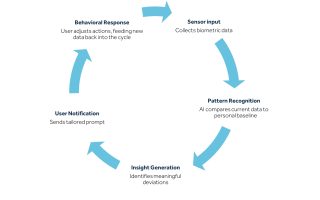
Wearables and Healthcare
Across the healthcare ecosystem, stakeholders increasingly recognize the transformative potential of wearables, and governments are beginning to position them as preventive health tools. In 2025, the United States Health Secretary launched a multi-million-dollar to promote fitness trackers, continuous glucose monitors, and similar technologies. Framed under the “Make America Healthy Again” initiative, the program emphasizes self-empowerment and personalized health monitoring, with the ambition of equipping every American with a wearable device within four years. Such large-scale public initiatives not only accelerate domestic adoption but also set a precedent that could shape how other nations integrate wearables into preventive health strategies.
The insurance sector is advancing along a similar trajectory. Insurers are increasingly drawing on wearable-derived data (such as step counts, heart rate variability, and sleep quality) to design more personalized incentive-based health engagement programs. Additionally, hospitals are increasingly integrating wearables into post-discharge and remote monitoring to track vital signs and detect early deterioration. For example, the Cleveland Clinic uses the Apple Watch for cardiac monitoring, Johns Hopkins developed EpiWatch for seizure detection, and Emory Healthcare employs the Apple Watch to more quickly respond to patient needs as they arise.
Challenges and Opportunities: What Must Evolve for Wearables to Thrive
Unlocking the full potential of wearables requires looking at both strengths and gaps. Progress depends not only on recognizing what these devices do well, but also on addressing where limitations remain. This section highlights four strategic areas that demand focus to advance the overall impact of wearables in everyday health.
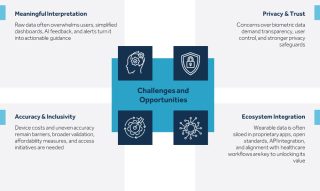
- Meaningful Interpretation: Wearables generate vast health metrics, but without clear interpretation users can feel overwhelmed or disengaged. Expert analysis warns that constant streams of data without actionable context risk leading to frustration or even device abandonment.
- Privacy and Trust: As wearables integrate deeper into daily life, privacy concerns are escalating. Surveys show growing consumer unease over data security, with many questioning how biometric information is stored or shared. Ethical reviews warn that without transparency and user control, adoption could slow even as the technology itself advances.
- Accuracy and Inclusivity: Advanced wearables deliver valuable insights, but cost remains a barrier that risks widening health equity gaps. Research highlights clear disparities in both usage and accuracy across income levels and racial groups. Expanding validation across diverse populations and improving affordability will be critical to scaling their impact.
- Ecosystem Integration: Wearable data often remain siloed within proprietary platforms, limiting their clinical value. A scoping review of electronic health record integration noted that, despite rising efforts by health systems and startups to embed wearable data into patient records, barriers of technology, workflow, and standardization continue to restrict broader adoption.
The Evolution Ahead: How AI Will Redefine Everyday Wellness
Wearables are shifting from reactive trackers to intelligent wellness agents, early-warning systems designed to anticipate health needs and deliver personalized insights.
AI-driven models are becoming adept at recognizing individual biological patterns. By continuously monitoring behaviors and bio-signals, wearables can identify subtle deviations (such as early signs of fatigue, stress, or inflammation) offering timely alerts before symptoms appear. At the same time, these systems are improving usability by converting complex data streams into clear recommendations.
Natural-language interaction is emerging as the next frontier. Soon, users will be able to ask wearables questions such as, “Why is my sleep different this week?” and receive phased, context-aware explanations. This shift will transform biometric feedback from raw data into conversation, reducing confusion and strengthening engagement.
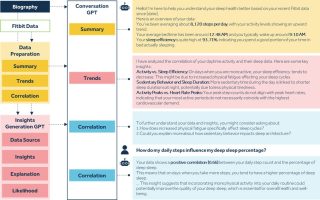
Conclusion
Wearables have advanced well beyond fitness tracking to become integral companions in daily health. Powered by AI and real-time insights, and increasingly recognized by healthcare systems, their role is expanding. Their greatest value is not in replacing medical tools, but in enabling individuals to take proactive steps toward managing and improving their wellbeing. As adoption accelerates, the path forward hinges on resolving key challenges, expanding accessibility, protecting privacy, and ensuring data accuracy and relevance. If these issues are addressed, wearables can serve as vital bridges between personal lifestyle choices and broader health ecosystems, strengthening their role as critical enablers of preventive care and personalized wellness.
Ultimately, the future of wearables lies less in the devices themselves and more in how effectively their data is harnessed. By translating continuous signals into actionable knowledge, they hold the potential to reshape how individuals, communities, and healthcare systems collectively approach health in the years ahead.
References:
- IDC Global (2025)
- ScienceDirect: The future of healthy ageing: Wearables in public health, disease prevention and healthcare (2025)
- The University of Arizona Health Sciences (2025)
- Medscape (2025)
- Axios (2025)
- Arxiv: AI on the Pulse: Real-Time Health Anomaly Detection with Wearable and Ambient Intelligence (2025)
- NPJ Digital Medicine (2024)
- Journal of Medical Internet Research (2024)
- Arxiv: PhysioLLM: Supporting Personalized Health Insights with Wearables and Large Language Models (2024)
- Deloitte (2024)
- EasySend (2023)
- The Wall Street Journal (2023)
- International Journal of Scientific Research & Engineering Trends (2022)
- Nature (2021)
Related articles
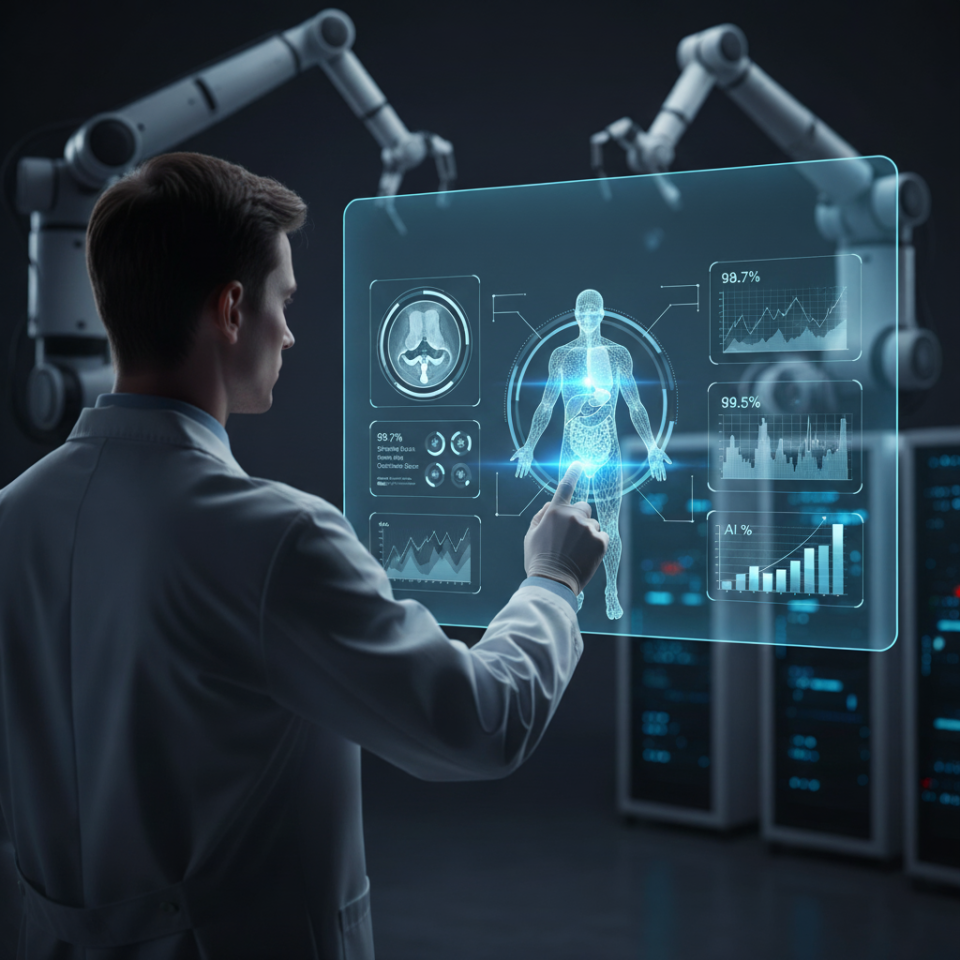
AI-Powered Diagnostics: The Future of Identifying Diseases Faster and Smarter

Innovations in Healthcare: Harnessing Technology for Better Outcomes
